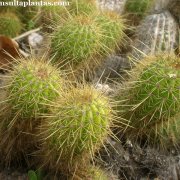Care of the cactus Stenocereus eruca or Creeping devil cactus |
|
The genus Stenocereus, family Cactaceae, includes about 20 species of cactus native to Mexico, the southern US, Central America, Venezuela and Colombia. Some species of the genus are: Stenocereus eruca, Stenocereus pruinosus, Stenocereus griseus, Stenocereus dumortieri, Stenocereus alamosensis, Stenocereus montanus. Common names: Creeping devil cactus, Caterpillar Cactus. This species is native to Baja California, Mexico. They are cacti with a cylindrical body and prostrate bearing that reach 3 meters (9.84 feet) in length. They have up to 12 ribs with elongated areoles that have 20 whitish radial spines and a longer central spine (up to 5 cm/1.96"). The very showy and scented white and pink flowers measure 6 cm (2.36") in diameter. Creeping devil cactus is used to cover dry, sunny slopes, in rockeries, in cactus and succulent gardens, and in pots when young. It's ideal for Mediterranean coastal gardens. Stenocereus eruca needs full sun exposure and a hot, dry climate. It resists temperatures of up to 2 ºC (35.6 ºF) if the substrate is dry. The soil can be a mixture, in equal parts, of coarse sand and leaf mulch; Caterpillar Cactus needs sandy soils with excellent drainage. Water moderately, waiting until the substrate has completely dried. In summer spray the stems periodically with lime-free water. Creeping devil cactus does not need fertilizers or pruning. Stenocereus eruca is a plant resistant to the usual pests and diseases but sensitive to excess moisture, especially in the roots. Caterpillar Cactus is easily propagated by stem cuttings; propagation from seed is a slow process. |
Images of the cactus Stenocereus eruca or Creeping devil cactus |
Find plants
Stenocereus eruca or Creeping devil cactus | Care and Growing
© 2026 FavThemes

